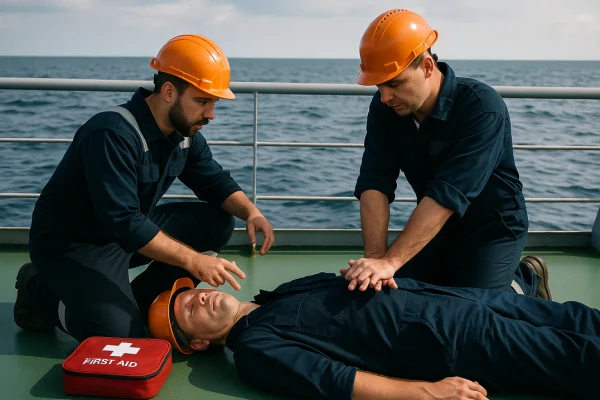Find out how medical care is accomplished aboard a ship without a doctor onboard. Learn about medical kits, first aid training, telemedicine, and handling real emergencies at sea.
Introduction
Seafaring presents various challenges, and among the most treacherous ones are medical emergencies. Unlike an onshore hospital or cruise liners, merchant vessels usually sail without a doctor on board. Hence, the crew has to go through training, be able to handle medical supplies, and draw on remote medical advice to deal with emergencies concerning health.
This blog sheds light on how seafarers take care of medical emergencies without the presence of a doctor, what resources are at their disposal, and how training and teamwork become critical in the saving of lives at sea.
The Reality of Sailing Without a Doctor
Merchant ships, especially cargo ships, usually do not have a full-time doctor because of crew size and cost considerations.
International instruments such as SOLAS and the Maritime Labour Convention (MLC) demand in lieu: that a ship should appoint a medical officer, who is essentially a senior officer trained in medical first aid and care. The Master holds ultimate responsibility for the health and safety of the crew.
The Ship’s Medical Kit & Equipment
Ships carry a medical chest stocked with medicines and equipment as mandated by flag states and international regulations. General Contents of the Medicine Chest
-the painkillers and anti-inflammatory drugs
-for infectious diseases: antibiotics
-for wound dressing and bandaging: dressings and bandages
-for seasickness and allergy: antiallergics and antinauseants
-basic diagnostic tools such as a stethoscope and a thermometer
Medical Training for Seafarers
The STCW Convention requires that all seafarers undergo training in basic first aid, including CPR, wound care, and treatment of common injuries.
Advanced medical officers are trained to assess, stabilize, and treat patients on long voyages. Training also covers record-keeping and the correct use of medical supplies onboard.
Using Telemedicine at Sea
Sometimes, the ship’s onboard medical resources aren’t enough. In those cases, the crew can get advice from doctors on shore using TMAS, connecting over radio or satellite. The Master or medical officer describes what’s happening — symptoms, vital signs, and sometimes even photos or short videos — to figure out the best treatment.
Medical emergencies onboard the sea may arise at any moment. Crew members may acquire cuts, burns, or fractured bones while carrying out cargo operations, fall sick due to food or dehydration, experience acute allergic reactions, or encounter heart attacks, strokes, or eye injuries from chemicals or welding.
In case an event is urgent and cannot be taken care of onboard, the vessel organizes a medevac. This may involve a helicopter pickup or sailing to the closest port. Coordinating with local authorities, the company, and the hospital onshore helps make sure the patient gets care quickly and safely
Pro tips for seafarers
Ensure that the medical kits are updated and that expiry dates are checked from time to time.
Conduct regular drill sessions for various types of medical emergencies.
Always make sure that you have read the ship’s medical manual.
Report every injury as soon as it happens to the Master.
Work out, remain fit, and maintain personal hygiene onboard.
Conclusion
Without a great doctor onboard, life gets a bit hard, but with proper preparation and equipping oneself with some training, with telemedicine, the seafarers can run any medical emergencies quite effectively. The health and safety of people on sea depend on every crew member; hence, the know-how and readiness to survive the oceans become paramount.


